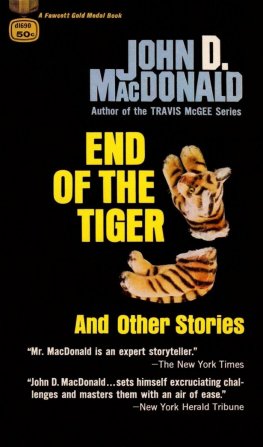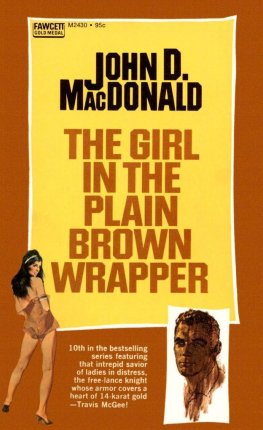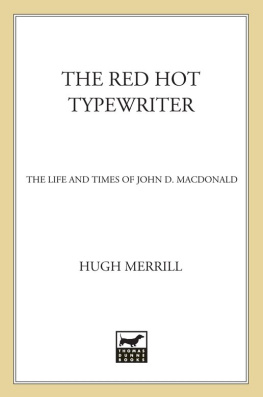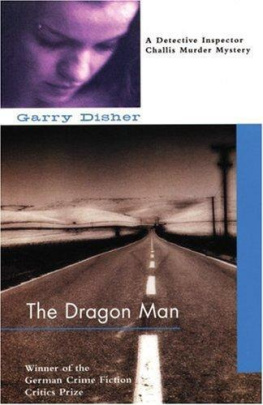John D. MacDonald
End of the Tiger and Other Stories
For Dorothy, friend, ornament, and buffer zone, among other things.
Copyright 1966 by John D. MacDonald.
Hangover 1956 by the Hearst Corporation.
The Big Blue 1949 by Popular Publications, Inc. This story was originally published by Popular Publications under the title Blue Water Fury.
End of the Tiger 1963 by United Newspapers Magazine Corporation. Reprinted from This Week Magazine.
The Trouble with Erica 1953 by the Hearst Corporation.
Long Shot 1955 by Popular Publications, Inc.
Looie Follows Me 1949 by Crowell-Collier Publishing Company.
Blurred View 1964 by United Newspapers Magazine Corporation. Reprinted from This Week Magazine.
The Loveliest Girl in the World 1964 by United Newspapers Magazine Corporation. Reprinted from This Week Magazine.
The Bear Trap 1955 by the Hearst Corporation.
A Romantic Courtesy 1957 by the Hearst Corporation.
The Fast Loose Money 1958 by the Hearst Corporation.
The Straw Witch 1964 by United Newspapers Magazine Corporation. Reprinted from This Week Magazine.
The Trap of Solid Gold 1960 by The Curtis Publishing Company.
Afternoon of the Hero 1966 by John D. MacDonald. This story was originally published in The Saturday Evening Post under the title Funnyman.
The Singular John D. MacDonald
Dean Koontz
When I was in college, I had a friend, Harry Recard, who was smart, funny, and a demon card player. Harry was a successful history major, while I passed more time playing pinochle than I spent in class. For the three and a half years that I required to graduate, I heard Harry rave about this writer named John D. MacDonald, John D to his most ardent readers. Of the two of us, Harry was the better card player and just generally the cooler one. Consequently, I was protective of my position, as an English major, to be the better judge of literature, dont you know. I remained reluctant to give John D a look.
Having read mostly science fiction, I found many of my professors assigned authors markedly less exciting than Robert Heinlein and Theodore Sturgeon, but I was determined to read the right thing. For every Flannery OConnor whose work I could race through with delight, there were three like Virginia Woolf, who made me want to throw their books off a high cliff and leap after them. Nevertheless, I continued to shun Harrys beloved John D.
Five or six years after college, I was a full-time writer with numerous credits in science fiction, struggling to move into suspense and mainstream work. I was making progress but not fast enough to suit me. By now I knew that John D was widely admired, and I finally sat down with one of his books. In the next thirty days, I read thirty-four of them. The singular voice and style of the man overwhelmed me, and the next novel I wrote was such an embarrassingly slavish imitation of a MacDonald tale that I had to throw away the manuscript.
I apologized to Harry for doubting him. He was so pleased to hear me proclaiming the joys of John D that he only said I told you so on, oh, twenty or thirty occasions.
Over the years, I have read every novel by John D at least three times, some of them twice that often. His ability to evoke a time and place mostly Florida but also the industrial Midwest, Las Vegas, and elsewhere was wonderful, and he could get inside an occupation to give you the details and the feel of it like few other writers Ive ever read. His pacing was superb, the flow of his prose irresistible, and his suspense watch-spring tight.
Of all his manifest strengths as a writer, however, I am most in awe of his ability to create characters who are as real as anyone Ive met in life. John D sometimes paused in the headlong rush of his story to spin out pages of background on a character. At first when this happened, I grumbled about getting on with the story. But I soon discovered that he could make the character so fascinating that when the story began to race forward again, I wanted it to slow down so I could learn more about this person who so intrigued and/or delighted me. There have been many good suspense novelists in recent decades, but in my experience, none has produced characters with as much humanity and truth as those in MacDonalds work.
Like most who have found this author, I am an admirer of his Travis McGee series, which features a first-person narrator as good as any in the history of suspense fiction and better than most. But I love the standalone novels even more. Cry Hard, Cry Fast. Where Is Janice Gantry? The Last One Left. A Key to the Suite. The Drowner. The Damned. A Bullet for Cinderella. The Only Girl in the Game. The Crossroads. All These Condemned. Those are not my only favorites, just a few of them, and many deal with interesting businesses and occupations. Mr. MacDonalds work gives the reader deep and abiding pleasure for many reasons, not the least of which is that it portrays the contemporary life of his day with as much grace and fidelity as any writer of the period, and thus it also provides compelling social history.
In 1985, when my publisher, Putnam, wanted to send advance proof copies of Strangers to Mr. MacDonald among others, I literally grew shaky at the thought of him reading it. I suggested that they shouldnt send it to him, that, as famous and prolific as he was, the proof would be an imposition on him; in truth, I feared that he would find the novel unsatisfying. Putnam sent it to him anyway, and he gave us an enthusiastic endorsement. In addition, he wrote to me separately, in an avuncular tone, kindly advising me how to avoid some of the pitfalls of the publishing business, and he wrote to my publisher asking her to please carefully consider the packaging of the book and not condemn it to the horror genre. She more or less condemned it to the genre anyway, but I took his advice to heart.
In my experience, John D. MacDonald, the man, was as kind and thoughtful as his fiction would lead you to believe that he must be. That a writers work accurately reflects his soul is a rarer thing than you might imagine, but in his case, the reflection is clear and true. For that reason, it has been a special honor, in fact a grace, to be asked to write this introduction.
Reader, prepare to be enchanted by the books of John D. MacDonald. And Harry, I am not as much of an idiot as I was in years gone by though I know you wont let me get away with claiming not to be to any degree an idiot anymore.
July 1956, Cosmopolitan
He dreamed that he had dropped something, lost something of value in the furnace, and he lay on his side trying to look down at an angle through a little hole, look beyond the flame down into the dark guts of the furnace for what he had lost. But the flame kept pulsing through the hole with a brightness that hurt his eyes, with a heat that parched his face, pulsing with an intermittent husky rasping sound.
With his awakening, the dream became painfully explicable the pulsing roar was his own harsh breathing, the parched feeling was a consuming thirst, the brightness was transmuted into pain intensely localized behind his eyes. When he opened his eyes, a long slant of early morning sun dazzled him, and he shut his eyes quickly again.
This was a morning time of awareness of discomfort so acute that he had no thought for anything beyond the appraisal of the body and its functions. Though he was dimly aware of psychic discomforts that might later exceed the anguish of the flesh, the immediacy of bodily pain localized his attentions. Even without the horizontal brightness of the sun, he would have known it was early. Long sleep would have muffled the beat of the taxed heart to a softened, sedate, and comfortable rhythm. But it was early and the heart knocked sharply with a violence and in a cadence almost hysterical, so that no matter how he turned his head, he could feel it, a tack hammer chipping away at his mortality.


![Bill Pronzini - Sleuths [short story collection]](/uploads/posts/book/922610/thumbs/bill-pronzini-sleuths-short-story-collection.jpg)




